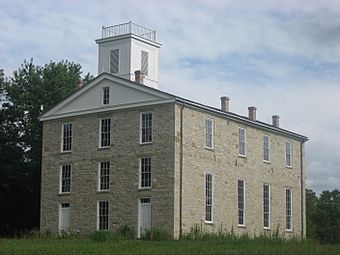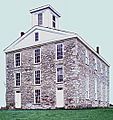Eleutherian College facts for kids
|
Eleutherian College Classroom and Chapel Building
|
|

Eleutherian College and Chapel Building
|
|
| Location | Lancaster, Indiana |
|---|---|
| Architectural style | Greek Revival |
| NRHP reference No. | 93001410 |
Quick facts for kids Significant dates |
|
| Added to NRHP | December 15, 1993 |
| Designated NHL | February 18, 1997 |
Eleutherian College was a special school founded in 1848 in Lancaster, Indiana. It was first called the Eleutherian Institute. Local Baptists who were against slavery started it. The name "Eleutherian" comes from a Greek word meaning "freedom and equality."
This school was unique because it welcomed all students, no matter their race or gender. This included people who had been enslaved or had escaped slavery. It was the second college in the United States west of the Allegheny Mountains and the first in Indiana to offer education to students of different backgrounds.
Classes began on November 27, 1848, teaching high school subjects. In 1854, it became Eleutherian College and started offering college-level courses. The school closed in 1874. Its main building was later used as a private school and then a public high school. Today, a non-profit group uses it.
The beautiful three-story stone building, which served as a chapel and classrooms, was built between 1853 and 1856. It has been restored and now works as a local history museum. The school was recognized as a National Historic Place in 1993 and a National Historic Landmark in 1997.
In the years before the American Civil War, about one-fourth to one-third of the students were African-American. The school was most popular between 1855 and 1861, with up to 150 students. After 1861, no black students were enrolled. During the Civil War, the college grounds were used for military training. The main building hosted meetings and concerts.
Contents
A School for Freedom and Equality
How Eleutherian College Started
The idea for Eleutherian College came from Reverend Thomas Craven. He was a Baptist minister and studied at Miami University in Oxford, Ohio. Reverend Craven was also an abolitionist, meaning he was against slavery. He believed that all people, regardless of their race, should be educated together.
Following his advice, members of the Neil's Creek Abolitionist Baptist Church started the Eleutherian Institute in 1848. This was its first name. Much of the early work was done by the Hoyt-Whipple family.
Lancaster: A Safe Place for Learning
From the 1830s to the 1860s, the area around Lancaster was known for its strong anti-slavery feelings. People in the community formed the Neil's Creek Anti-Slavery Society in 1839. They also created the Neil's Creek Abolitionist Baptist Church in 1846.
Lancaster was an important stop on the Underground Railroad. This was a secret network that helped enslaved people escape to freedom. Many abolitionist families in the area, including some who helped run the school, were active in the Underground Railroad. Because of these strong anti-slavery beliefs, Lancaster was a perfect place for a school that welcomed everyone.
First Classes and Growth
The Eleutherian Institute opened its doors to students of all races and genders. This included people who were formerly enslaved or had escaped slavery. The name "Eleutherian" comes from the Greek word eleutheros, which means "freedom and equality."
The first classes began on November 27, 1848. Fifteen students met in an old building near Lancaster. Reverend John G. Craven, the son of Reverend Thomas Craven, was the school's first teacher. He was the principal until 1861.
Reverend Thomas Craven donated the land for the school's campus. Two new buildings were built on College Hill in the 1850s. One was a dormitory, built around 1854. The other was the stone chapel and classroom building, finished between 1854 and 1856.
Becoming a College
In 1854, the institute was renamed Eleutherian College. This happened when it started offering college-level courses. This made it the second college west of the Allegheny Mountains to offer education to all races. Oberlin College was the first. Eleutherian College was the very first in Indiana to do so.
In the ten years before the Civil War, about one-fourth to one-third of the students were African-American. Some came from as far away as New Orleans, Louisiana, and Jackson, Mississippi. Most came from Kentucky. The school was most popular between 1855 and 1861. At one point, it had 150 students. Some records show 200 students in 1860, with 50 African Americans. These students came despite laws that made it hard for black people to travel or live in Indiana. After 1861, no black students were enrolled.
During and After the Civil War
During the American Civil War, some former students joined the 6th Indiana Infantry Regiment. They trained on the college grounds. The college buildings were also used for meetings and concerts during the war.
After John Craven left in 1861, other principals led the school. Eleutherian College closed in 1874. However, John Craven returned in 1878 to help reopen it as a private high school and teacher training school. He stayed until 1887.
In 1888, the local government bought the main building. They used it as a public school. This public school closed in 1938. The building was then left empty for a while.
Saving the Historic Building
Restoration work on the main building began in the 1960s. In 1973, a group called Historic Madison received the school as a gift. They sold it in 1990. The new owners formed a non-profit group called Historic Eleutherian College Incorporated in 1996.
The chapel and classroom building has been carefully restored to look like it did in the 1850s. Today, Historic Eleutherian College runs the building as a local history museum.
What the College Looked Like
Reverend Thomas Craven gave the land for the school. Eventually, two new buildings were built on College Hill in the 1850s. The main building held the chapel and classrooms. A second building was a dormitory for students. Both buildings were made from rough-cut limestone found in nearby quarries.
The main building is three stories tall and was finished in 1856. It has a chapel and seven other rooms. It measures about 65 feet (20 meters) long and 42 feet (13 meters) wide. Its classrooms could hold 200 to 300 students. The dormitory, built around 1854, had fifteen rooms. It measures about 55 feet (17 meters) long and 33 feet (10 meters) wide.
Outside the Building
The main building was built in the Greek Revival style between 1854 and 1856. It has a rectangular shape. A square bell tower, called a belfry, sits in the middle above the main entrance. The roof is shaped like a triangle, with a wooden pediment above the third-floor windows.
The window sills, lintels (the tops of windows), and corner quoins (decorative blocks) are made of smooth limestone. This contrasts with the rough stone walls. The front of the building has three sections. It has two wooden doors with a window between them on the first floor. The sides of the building look the same, with four tall windows on the lower levels and four more on the third floor.
Inside the Building
Inside the main building, a small entrance leads to a two-story chapel. This chapel runs the entire length of the building. It has tall windows and a balcony on the north side. The chapel ceiling is covered with wooden panels.
Stairs at each end of the entrance hall lead to the upper floors. The second floor has two classrooms above the entryway. The third floor has five more rooms. Stairs in one of the third-floor rooms lead to an unfinished attic. A ladder in the attic goes up to the bell tower. The bell was made by J.A. Kelley in Madison, Indiana.
Special Recognition
The restored main building, which is now a public museum, received important recognition. It was added to the National Register of Historic Places in 1993. Then, on February 18, 1997, it was named a National Historic Landmark.
The National Park Service also lists the building as a Network to Freedom Site. This means it's recognized for its connection to the Underground Railroad. In 2004, the Indiana Historical Bureau placed a state historical marker at the college. This marker honors its role as one of Indiana's first schools to welcome students of all races and genders.
Famous Students
Eleutherian College had some very important students.
One notable African-American student was Moses Broyles. He had been enslaved in Kentucky but bought his freedom as an adult. He later became a pastor at the Second Baptist Church in Indianapolis. He also helped start the Indiana Association of Black Baptists Churches in 1858.
Among the notable female students was Sarah B. Hoyt. She also studied at Oberlin College. Sarah became a teacher and later a high school principal in Newport, Kentucky. Rebecca J. Thompson was another important student. She became the head of the mathematics department at Franklin College (Indiana) for 38 years. She retired in 1910.
Images for kids
See also





